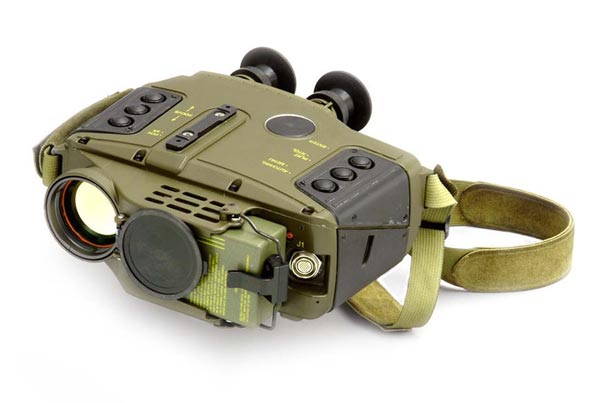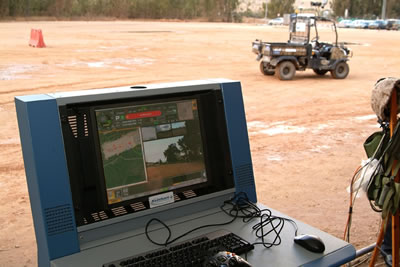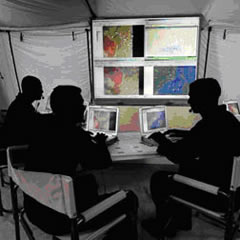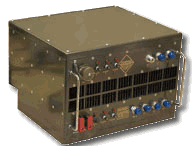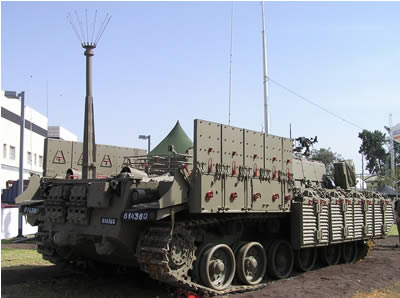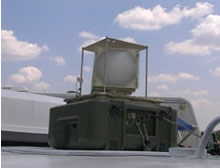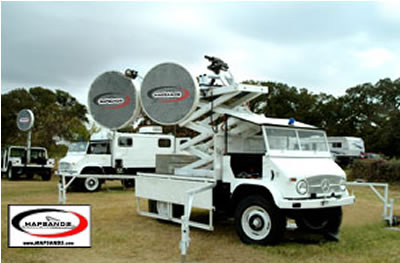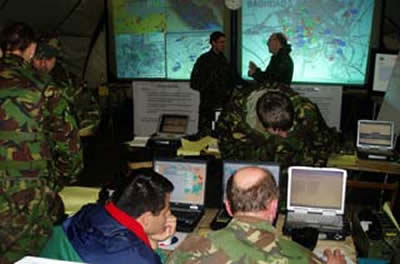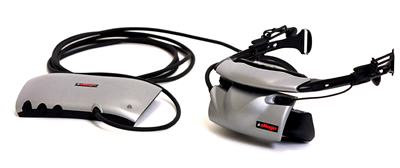The 9K331 Tor [SA-15 GAUNTLET land-based, SA-N-9 naval version] low-to-medium altitude SAM system is capable of engaging not only aircraft and helicopters but also RPVs, precision-guided weapons and low flying cruise missiles. The sophisticated Tor system could ensure reliable protection for government, industrial and military sites.
Western intelligence reports indicate that efforts to increase Iran’s air defense capability have lately been stepped up. Mostafa Mohammed Najjar, minister of Defense and Logistics Procurement stated clearly in the Parliament “developing and expanding the air defence system and missiles are the highlights of the programmes of the (Iran) defence industries”. Sofar the Iranians have been unable to build a nationwide, integrated air defense network. As a result, the Iranian military relies entirely on point defense of key locations using surface-to-air missile (SAM) batteries. The present Iranian air defense arsenal includes small numbers of Chinese model SA-2s and Russian SA-5 and SA-6 SAMs. Substantial efforts have been made for years to purchase the highly capable SA-10 Grumble missile system that the Russians have been aggressively marketing as the S-300. According to intelligence assessments, the heaviest-defended areas include Tehran and R&D and production centers involved in the Iranian nuclear, chemical and biological weapons programs. One key facility defended with the antiaircraft weapons is the nuclear complex at Bushehr.
Iran air defense Update
The existing early warning systems, built in the 1950s under the auspices of CENTO, were upgraded in the 1970s with a modern air defense radar network. Following the 1979 Khomeini Revolution, Washington canceled an ordered AWACS sale, which left the air force’s SA-2 and SA-6 SAM battalions and eight improved Hawkbattalions as the basis for Iran’s air defense. Five squadrons containing ageing British Rapier and obsolete Tigercat missiles as well as Swedish RBS-70 short-range missiles were used primarily for short range, low level defense (primarily air bases), but there is an acute shortage of spare parts to keep the systems combat ready. In 1995 Russia agreed to sell Tehran five batteries of their Almaz SA-5 ‘Gammon’ SAMs , the Iranian air defense corps declared these operational in 1997.
The SA-5 substantially improved Iran’s air defense capacity at the time, yet, with modest acceleration and limited maneuverability, the Gammon was designed to intercept strategic bombers, and could not be updated to engage highly maneuverable strike fighters and precision guided weapons. Furthermore, its mechanically steered radars are vulnerable to saturation by decoys and jammers. The five batteries currently in the inventory would be able to deploy around up to six prime objectives only. There were persistent reports in the professional media, that Iran was pressuring Russia, and other sources, to purchase a number of SA-10 batteries to modernize their air defense. Some reports indicated that Iran may have acquired a number of these systems by smuggling components from Russia, Croatia and Kazakhstan, but these reports seem unreliable. In March 2001 there were reports that the Russians are close to cutting a deal with Iran on advanced missiles. Itar-Tass reported that Iran would soon close the deal on the Russian Tor-M1, Tor-M1T, and the S-300 surface-to-air missiles. One unconfirmed intelligence news source claims that Iran has received at least two batteries of SA-10 (of the S-300PMU type) SAMs from Russia. According to this source these became operational in February 2003, and have been deployed in the Tehran area.
When deployed in an integrated network, an array of S-300 and TOR-M1 systems could pose a highly potent defensive network against any aggressor, with the long range S-300 neutralizing aggressors and support planes at the high altitude, long range domain while the TORs engaging UAVs, precision guided weapons, cruise missiles and anti-radiation missiles, launched at the the SAMs, radars and protected sites.
There only scanty reports over Iranian Key SAM-defended areas. Known locations include Tehran and the strategic military industrial centers. Iran appears to have deployed the SA-5 batteries to defend Tehran, major ports, and oil facilities, providing long-range medium-to-high altitude coverage of vital coastal installations. The Hawk and SA-2 batteries are reportedly located around Tehran, Isfahan, Shiraz, Bandar Abbas, Kharg Island, Bushehr, Bandar Khomeini, Ahwaz, Dezful, Kermanshah, Hamadan, and Tabriz, providing point defense for key bases and facilities. Some of these sites lack sufficient missile launchers to be fully effective.
There have been limited attempts to locally design and produce indigenous air defense systems. One of these is the so-called ‘Sayyad-1’ missile. On 14 April 1999 the Iranian armed forces carried out a successful test of this locally made surface-to-air missile. A spokesman of the Iranian Ministry of Defense reports, “the missile was able to hit its target at an appropriate altitude.” This missile was designated Sayyad-1, named for assassinated commander Lt-Gen. Ali Sayyad-Shirazi, the notorious “Butcher of Kurdistan”, who was killed by the Muhajedin opposition that year. Iranian defense ministry officials acknowledged that the Sayyad-1 missile was an SA-2 of Chinese design, but was at least partially manufactured in Iran. Chinese Aviation Industry Minister Zha Yuli was “on an official visit to the strategic Iranian town of Qeshm in Bushehr province” at the time the missile is test-fired. Chinese ambassador to Iran, Wang Shijie, accompanied him on the trip. Another report suggested that the Sayyad-1 medium to long range air defense missile was developed locally using elements of technologies of the Hawk and Standard missiles, Having upgraded the missile’s warhead, the Iranians claimed that range was increased to 45-50 kilometers.
Another locally produced air defense system seems to be the Chinese origin Feimeng 80 air defense missile, a point defense weapon said to be deployed to defend military bases. The system comprises pedestal-mounted MANPADS, similar to the Boeing Avenger, and has been suggested as having potential to engage cruise missiles using an E/F-band acquisition radar and a J-band engagement radar. China first publicly displayed its mobile low-altitude and ultra-low-altitude missile “Feimeng-80 (Flying Midge) during official displays in the early 90’s. The system uses a combination of infrared, TV and radar sensors, guiding the missile by radio command. This method enables the system to remain passive until the missile is launched. It is yet unclear weather the missile is produced locally by Iran or imported from China.
An improved version of the Feimeng-90 was fielded in 1998, introducing a new radar covering a range of 25,000 meters (compared to 18,400 of the previous model). Maximum speed of the missile has been increased from 750 m/sec. to 900 m/sec., and maximum range now from 12,000 meters to 15,000 meters.
Some reports indicate that China has modernized some of Iran’s surveillance radars. Such radars produced by the China National Electronics Import-Export Corporation which can detect targets up to 300 km away could now be part of Iran’s air defense system.
But even with these latest acquisitions, Iran’s air defenses remained porous. An Operational assessment indicates that launchers are scattered too widely preventing rapid reaction and becoming vulnerable to enemy suppression. The current system lacks low altitude radar coverage, overlapping radar network, command and control integration, sensors, and electronic counter-countermeasures (ECCM), all basic elements of modern, effective air defense network. The US has already mapped most of the Iranian defensive system, by playing a “can and mouse” game, penetrating the Iranian airspace with strike aircraft and UAVs, luring the air defense network to activate its sensors, revealing the “electronic Order of Battle (EOB), typical operational characteristics, placements of assets and concepts of operation. Iran may at best be able to field a limited point defense for its most vital objectives. The present deal for 29 TOR M-1 systems could partly enhance this deficiency, although, when integrated with high altitude interceptors, such stop-gap defenses could become quite effective even against a determined, well equipped offensive.
And this precisely presents the acute dilemma for Tehran’s efforts towards a viable air defense around its emerging nuclear site infrastructure. Nodal analysis provides one method of increasing the scope of an air campaign without increasing its size. The focus is on system criticality and vulnerability to attack. Striking only the most pivotal target systems requires precise intelligence, which is a crucial element in mounting such a critical attack. There are several such ‘node’ targets in Iran, according to intelligence analyst’s estimate. A major location is the Uranium hexafluoride (UF6) conversion site at the Rudan Nuclear Research Center near Shiraz, which represents a primary target for counter-proliferation strikes. Another are the important Uranium enrichment facilities, a problematic target set within a large site at Natanz. Israel Military Intelligence refers to this site as “Kashan.” Natanz is located between Isfahan and Kashan in central Iran. The facility is reportedly 100 miles north of Isfahan, and is located in old Kashan-Natanz, near a village called Deh-Zireh. A new site under construction and only recently detected by satellite, is the Ardekan Nuclear Fuel Unit. This site, reportedly scheduled to be completed in mid-2005, is located at the 33rd kilometer (20.5 miles) of the Ardekan – Choupanau Road. Another highly important target would be Isfahan said to be the primary location of the Iranian nuclear weapons program. The Nuclear Technology/Research Center in Isfahan is Iran’s largest nuclear research center.
Operational Assessment
Iranian air defenses may have some potential to complicate western planning and distract effort on major targets, despite suffering from key weaknesses, but at its present strength the arsenal and infrastructure cannot really prevent a determined attack on its strategic target list.
The Achilles heel of the system remains its inability to generate effective real-time early warning and acting as a fully integrated system. The small number of surveillance radars could be engaged using PGM, or low-flying Tomahawk cruise missile strikes. Plenty of low-level approaches could be maintained along the ‘creases’ in the widely-spread air defense network caused by Iran’s mountainous terrain. The lack of centralized control and C4I network responsible for an overall national air defense could be exploited by deception and electronic warfare techniques. The bureaucratic harmony, as well as inter-service rivalry and distrust will only make things worse. Yet, the potential existence of two newly arrived batteries of Almaz S-300PMU, could dramatically change the situation and pose a significant challenge to any aggressor, especially if coordinated with low-altitude Tor systems functioning as “anti-PGM” elements.
Despite its obsolescence, Iran’s air defenses remain an unpredictable adversary. Despite its porosity, its SAM forces cover all altitudes, with mobile, rapidly deployable elements that could effectively evade preplanned attacks by Tomahawk missiles. Locally modified and improved systems could pose technical challenge to electronic warfare and countermeasures. The latest acquisition of the advanced TOR M-1 surface-to-air missiles, although insufficient to cover all key node targets of Iran’s nuclear and ballistic missile infrastructure, could become a distinct problem due to their highly sophisticated technologies, still fully unacquainted to western intelligence.

